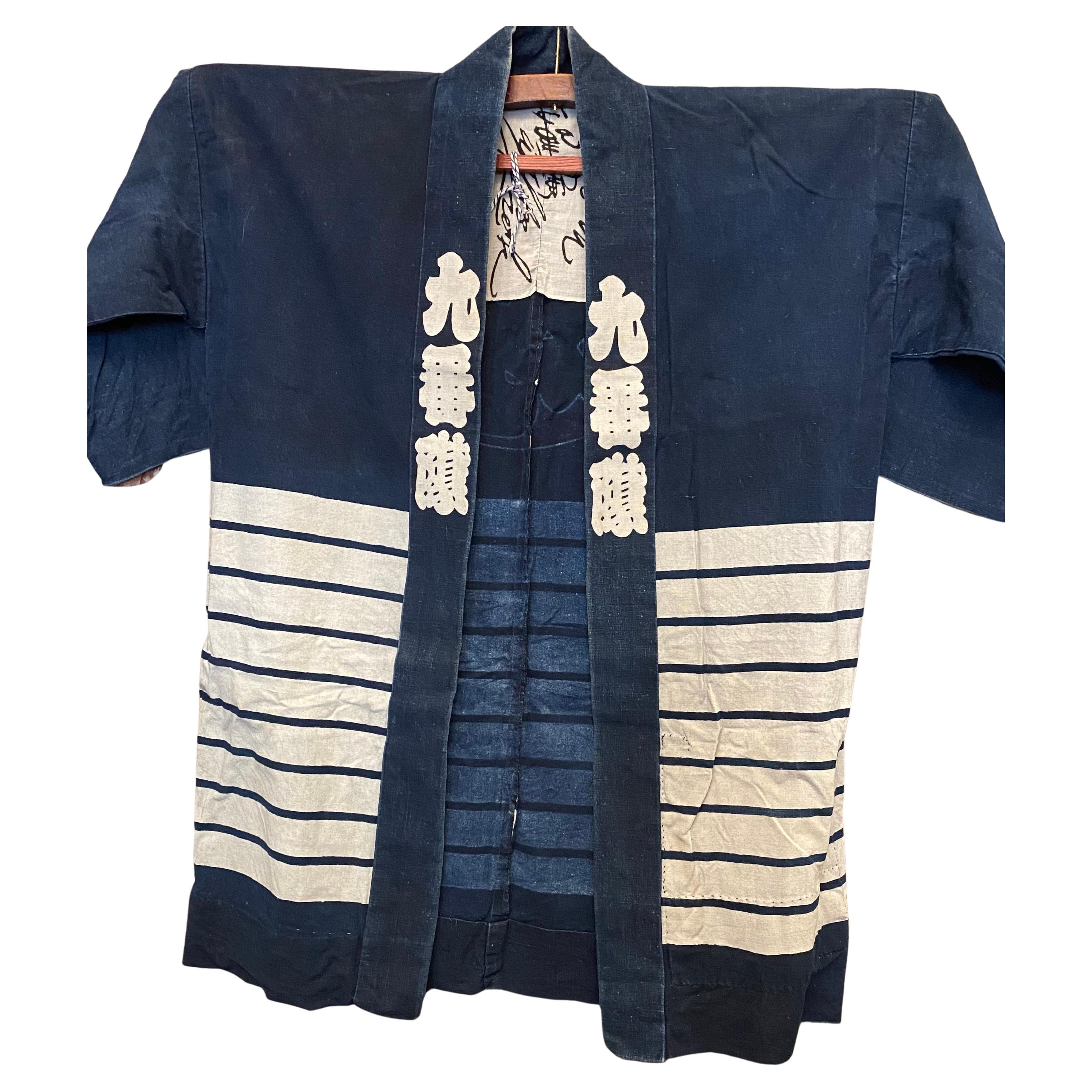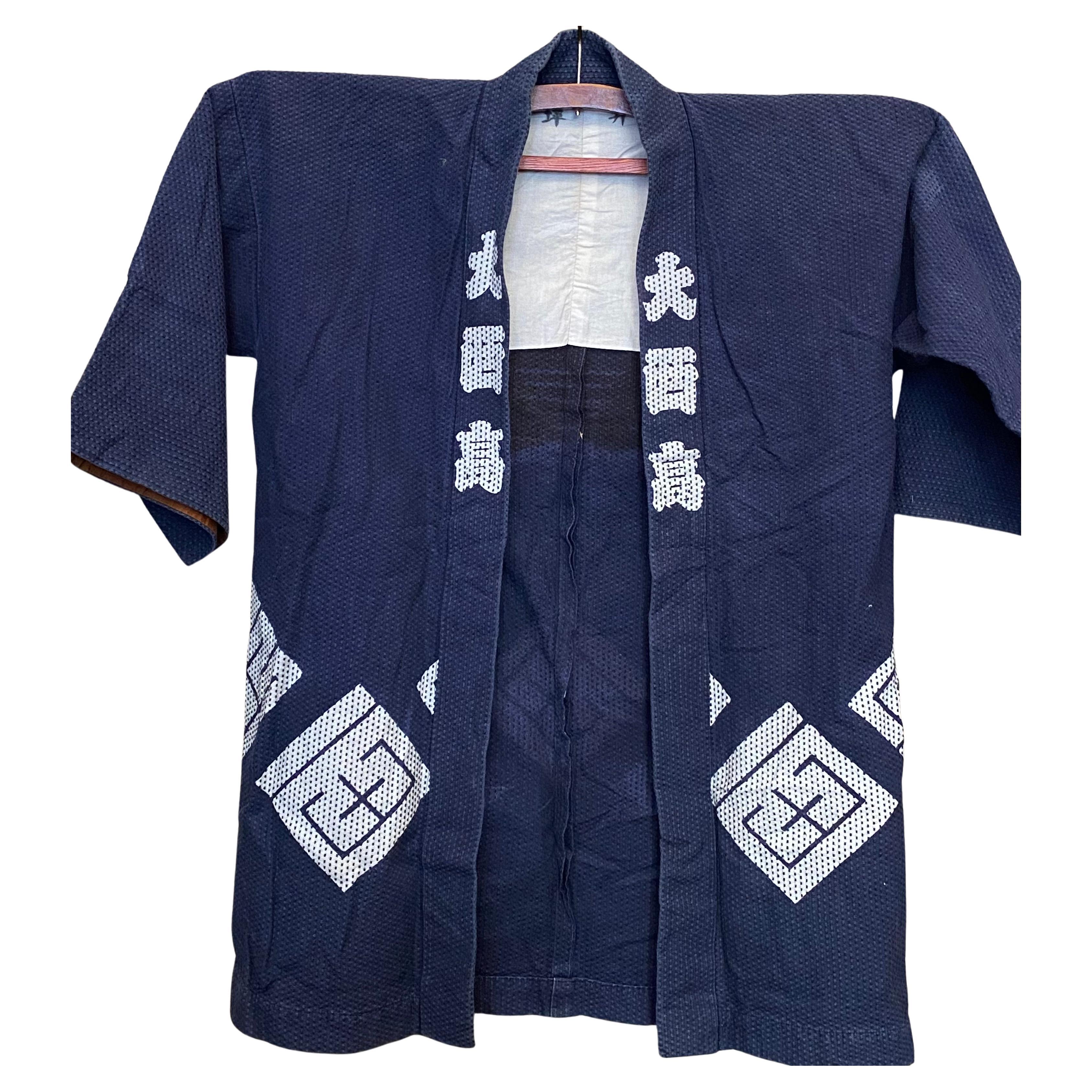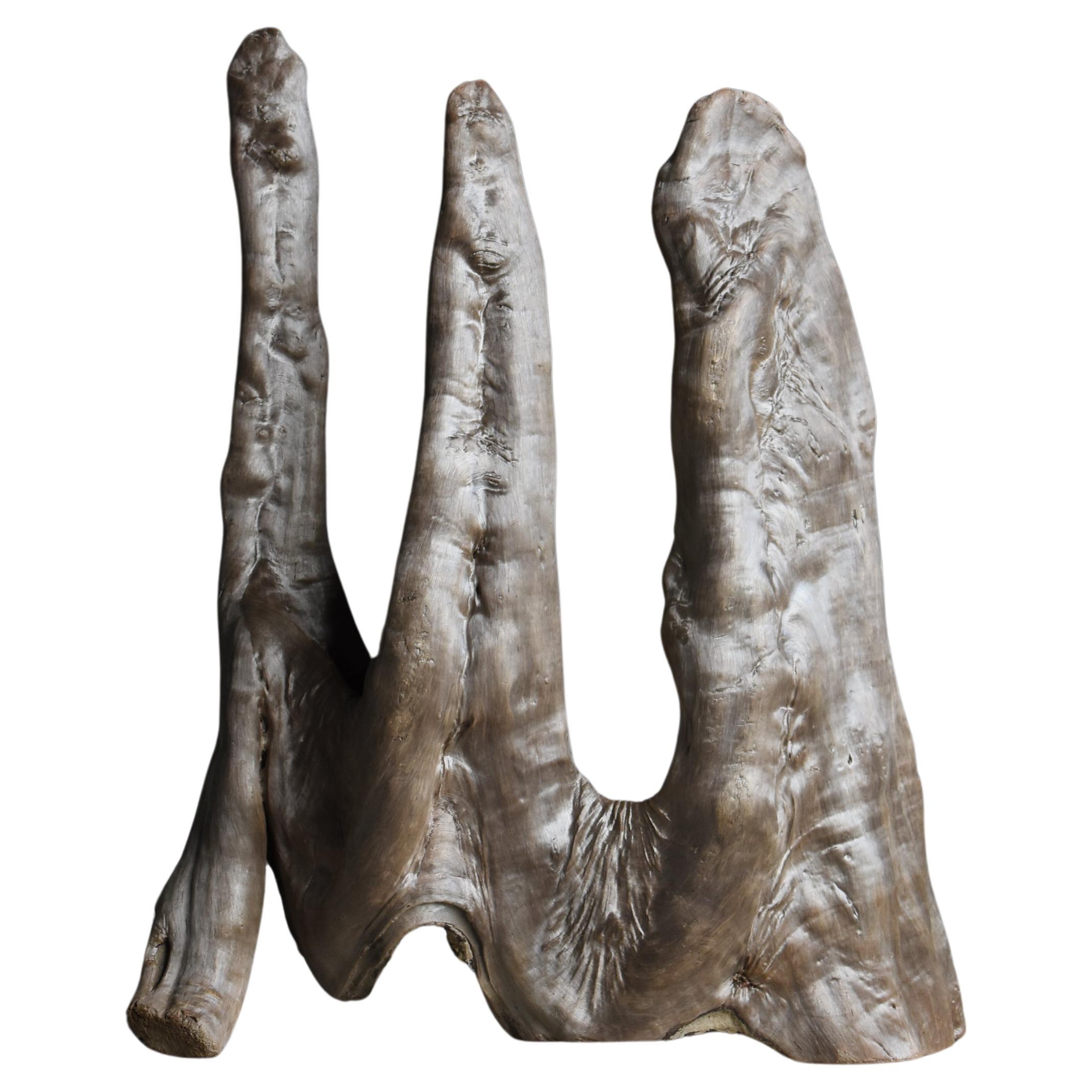Items Similar to Japanese Antique Shirushi-Hanten Jacket Cotton 'Oohata Chaten' 1900s
Want more images or videos?
Request additional images or videos from the seller
1 of 12
Japanese Antique Shirushi-Hanten Jacket Cotton 'Oohata Chaten' 1900s
About the Item
This is a jacket with cotton which was made in Japan.
These kind of jackets are called Hanten in Japanese.
Hanten is a short jacket similar to a haori, but without a gusset. It is worn without a breast strap and without the collar folded back.
This hanten is specially called Shirushi b(h)anten. Shirushi banten is dyed with a familly crest or a store name.
On this shirushi hanten, it is written 'Cha Oohata'.
Cha Oohata= Tea Oohata= Oohata/Ohata tea shop
Oohata chaten is a name of shop, chaten means tea shop.
Oohata chaten is situated in Komatsu city, Ishikawa prefecture.
This shop is established during Keio era. It is between 1865 to 1868.
Dimensions:
Length 95 cm
Width 127 cm
Sleeve length 32 cm
Sleeve height 33 cm.
- Dimensions:Height: 37.41 in (95 cm)Width: 50.01 in (127 cm)Depth: 0.4 in (1 cm)
- Materials and Techniques:
- Place of Origin:
- Period:
- Date of Manufacture:1900
- Condition:This shirushi banten is an antique item and made almost 100 years ago. It is not new and you can see the condition from these photos.
- Seller Location:Paris, FR
- Reference Number:1stDibs: LU6325233248362
About the Seller
No Reviews Yet
Vetted Seller
These experienced sellers undergo a comprehensive evaluation by our team of in-house experts.
1stDibs seller since 2022
29 sales on 1stDibs
Typical response time: 15 hours
- ShippingRetrieving quote...Ships From: Paris, France
- Return PolicyThis item cannot be returned.
More From This SellerView All
- Japanese Cotton Shirushi Hanten Bishamonten, 1940sLocated in Paris, FRThis is a jacket with cotton which was made in Japan. These kind of jackets are called Hanten in Japanese. Hanten is a short jacket similar to a haori, but without a gusset. It is...Category
Vintage 1940s Japanese Showa Antiquities
MaterialsCotton
- Japanese Vintage Hanten Cotton Jacket 'Asai' 1940sLocated in Paris, FRHanten is a type of traditional Japanese garment that is often referred to as a "short coat" or "jacket". `it has a loose, kimono-like design with a straight collar and is typically ...Category
Mid-20th Century Japanese Showa Antiquities
MaterialsCotton
- Japanese Cotton Hanten, 1930sLocated in Paris, FRThis is a jacket with cotton which was made in Japan. These kind of jackets are called Hanten in Japanese. Hanten is a short jacket similar to a haori, but without a gusset. It is...Category
Vintage 1930s Japanese Showa Antiquities
MaterialsCotton
- Japanese Antique Hanten with Cotton showa (ver1960s)Located in Paris, FRHanten is a type of traditional Japanese garment that is often referred to as a "short coat" or "jacket". `it has a loose, kimono-like design with a straight collar and is typically ...Category
Vintage 1960s Japanese Antiquities
MaterialsCotton
- Japanese Antique Hanten "Onishiko" with Cotton showa (around 1960s)Located in Paris, FRHanten is a type of traditional Japanese garment that is often referred to as a "short coat" or "jacket". `it has a loose, kimono-like design with a straight collar and is typically ...Category
Vintage 1960s Japanese Antiquities
MaterialsCotton
- Antique Japanese Wooden Nestuke 'Three Turtles' 1900s Meiji EraLocated in Paris, FRThis is an antique netsuke made in Japan around meiji period 1900s. Netsuke is a miniature sculpture, originating in 17th century Japan. Initially a simply-carved button fastener on...Category
Antique Early 1900s Japanese Meiji Antiquities
MaterialsWood
You May Also Like
- Japanese Antique Tree Object 1900s-1940s / Wabi SabiLocated in Sammu-shi, ChibaSince ancient times, people have created and inherited necessary tools from familiar materials to survive in the severe struggle against nature, and have nurtured a lifestyle culture. Over the years, tools acquire a distinctive flavor and reflect the way of life. The more severe the natural environment and the weaker we are, the stronger the power of tools becomes. In today's world, where cheap and disposable products are encouraged, the act of repeatedly re-creating things around us by modifying them opens up a new world. With this philosophy in mind, we have carefully selected beautiful, powerful, and unique Japanese antiques. This is an old wooden object...Category
Mid-20th Century Japanese Showa Antiquities
MaterialsPine
- Japanese Antique Wooden Horse Tricycle 1860s-1900s / Sculpture WabisabiLocated in Sammu-shi, ChibaVery old tricycle with wooden horse made in Japan. It is from the Meiji period (1860s-1900s). It is made of iron, cedar wood, straw, and paper. In Japan ...Category
Early 20th Century Japanese Meiji Antiquities
MaterialsIron
- Japanese Antique Paper Tray 1860s-1900s/Mingei Wabi-Sabi ObjectLocated in Sammu-shi, ChibaThis is a very old Japanese paper plate. It is from the Meiji period (1860s-1900s). It is made of thick paper and very solid. It is called a "cocoon dish. It was used to collect s...Category
Early 20th Century Japanese Meiji Antiquities
MaterialsPaper
- Antique 1900s Persian Zelesultan Rug, 5' x 7'Located in New York, NYThis Persian Zelesultan (or "King's Shadow") carpet was created, circa 1900 using a cotton warp and weft, hand-knotted wool pile and natural vegetable dyes. Commissioned by a prince ...Category
Early 20th Century Persian Persian Rugs
MaterialsWool
- Japanese Antique Wooden Boat 1860-1900s / Wood Bowl Wabi Sabi MingeiLocated in Sammu-shi, ChibaThis is a very old Japanese wooden boat. It is a piece of furniture from the Meiji period (1860s-1900s). It is made of cedar wood. We found it in an old house along the overseas in ...Category
Early 20th Century Japanese Meiji Antiquities
MaterialsCedar
- Japanese Antique Ceramic Large Shrine of God "ZUSHI" 1860s-1900s / WabisabiBy Axel VervoordtLocated in Sammu-shi, ChibaThis is a very old and large ceramic shrine made in Japan. It is called “zushi” in Japanese. It is usually made of wood, but this one is ceramic. It is...Category
Early 20th Century Japanese Meiji Antiquities
MaterialsCeramic





